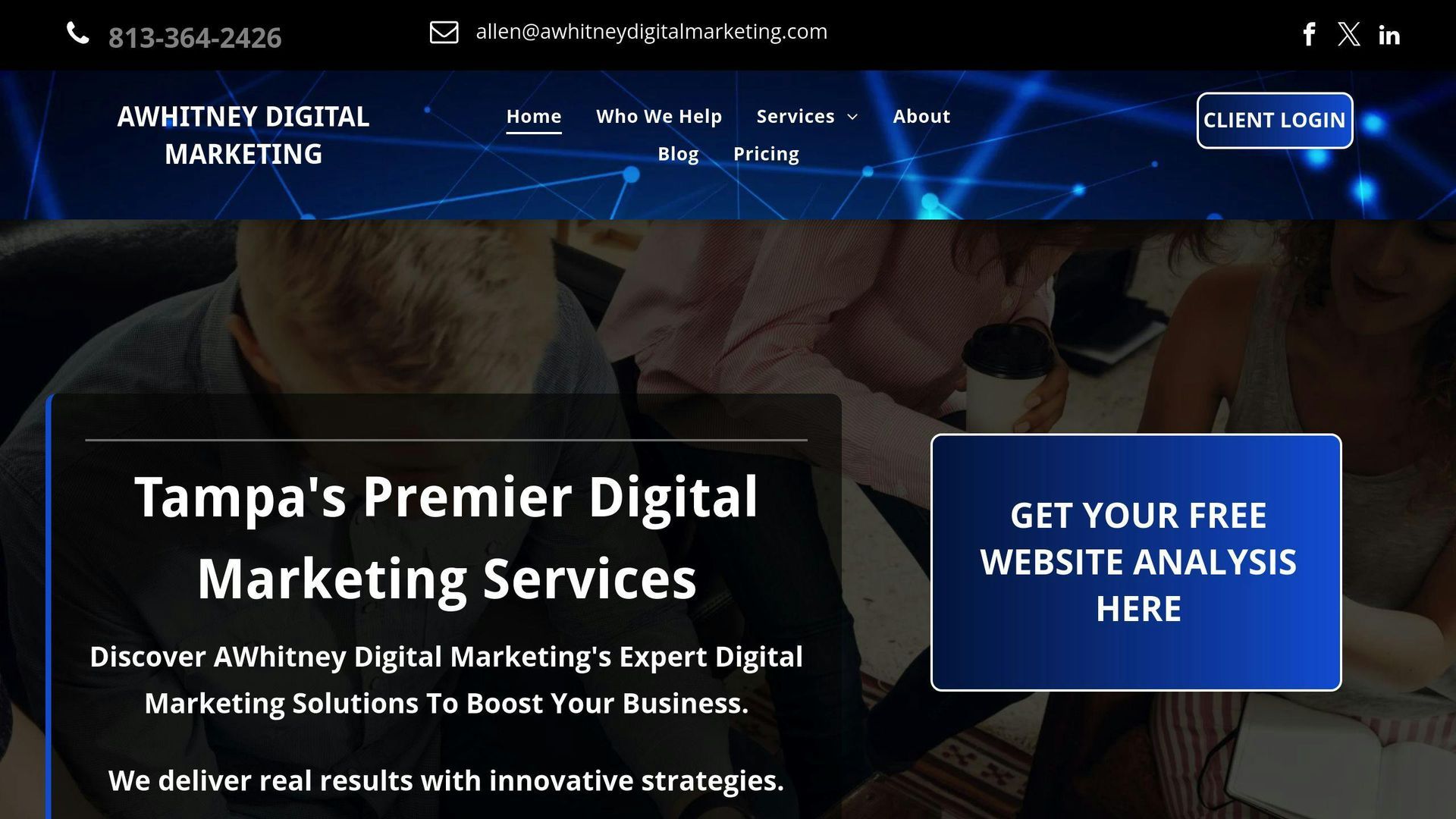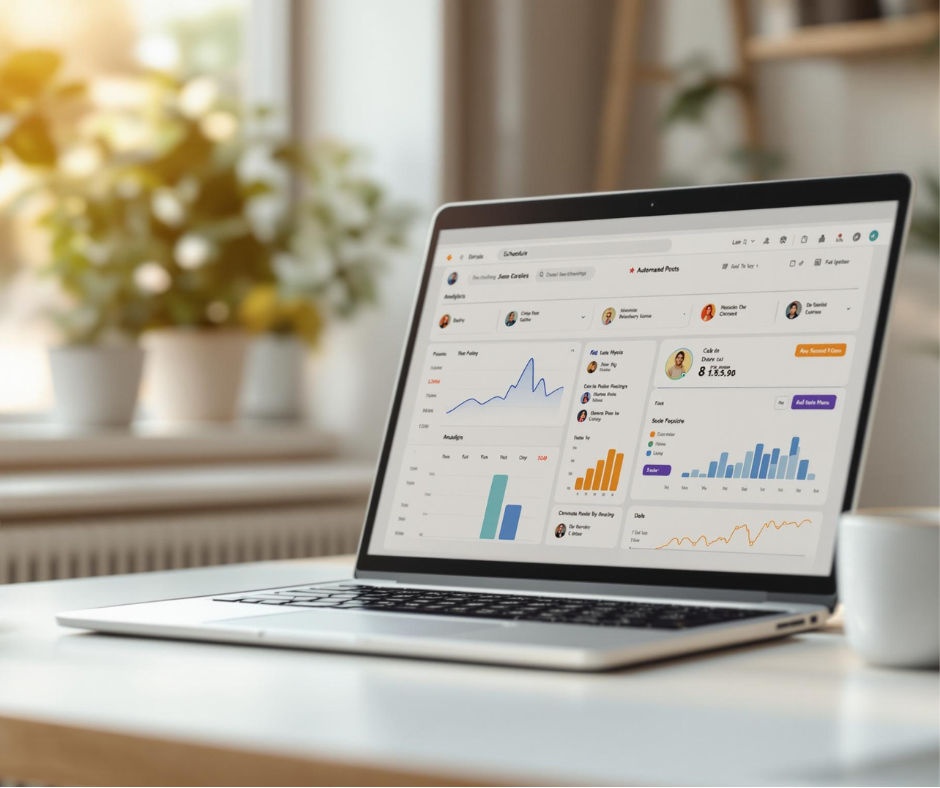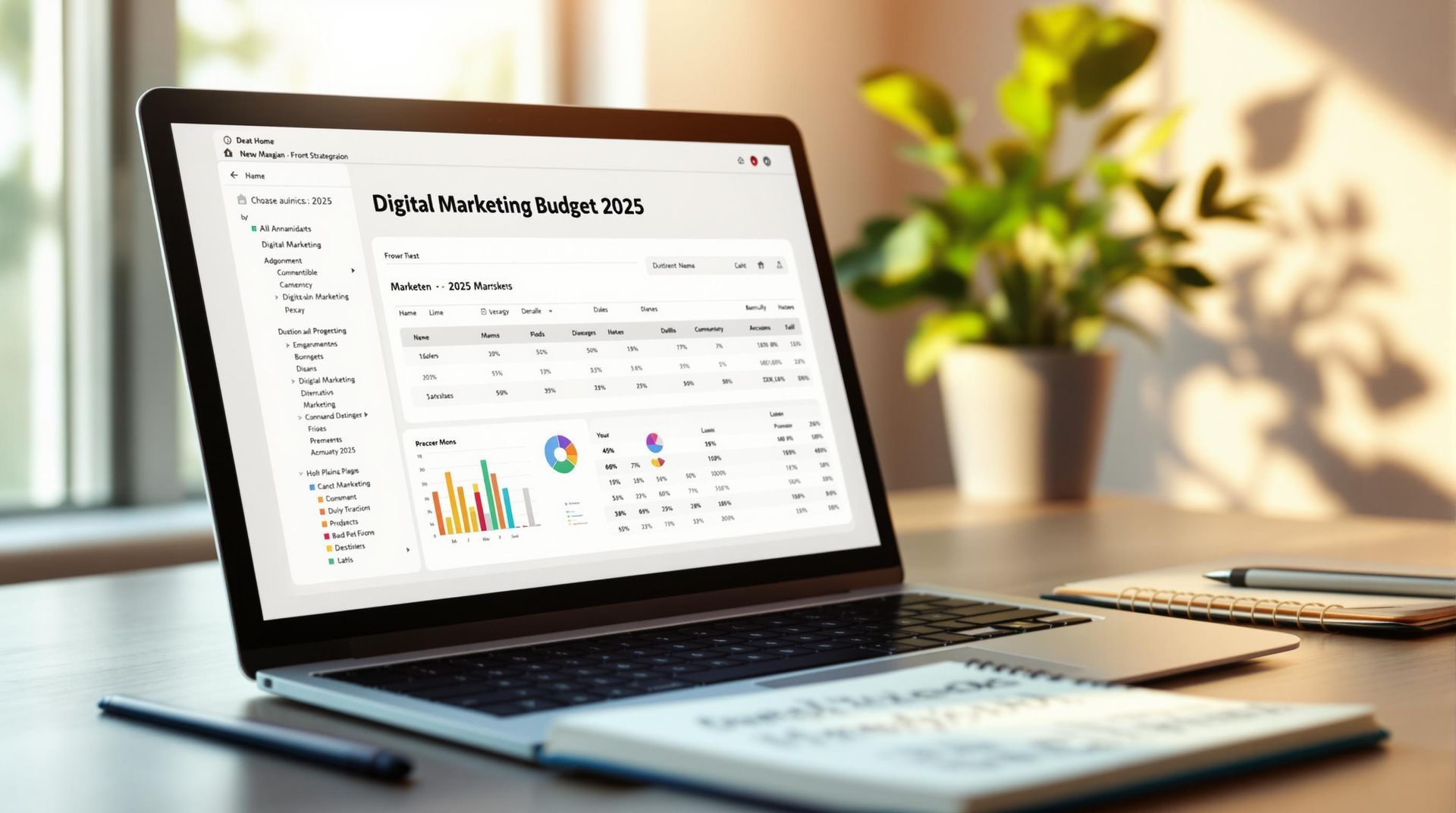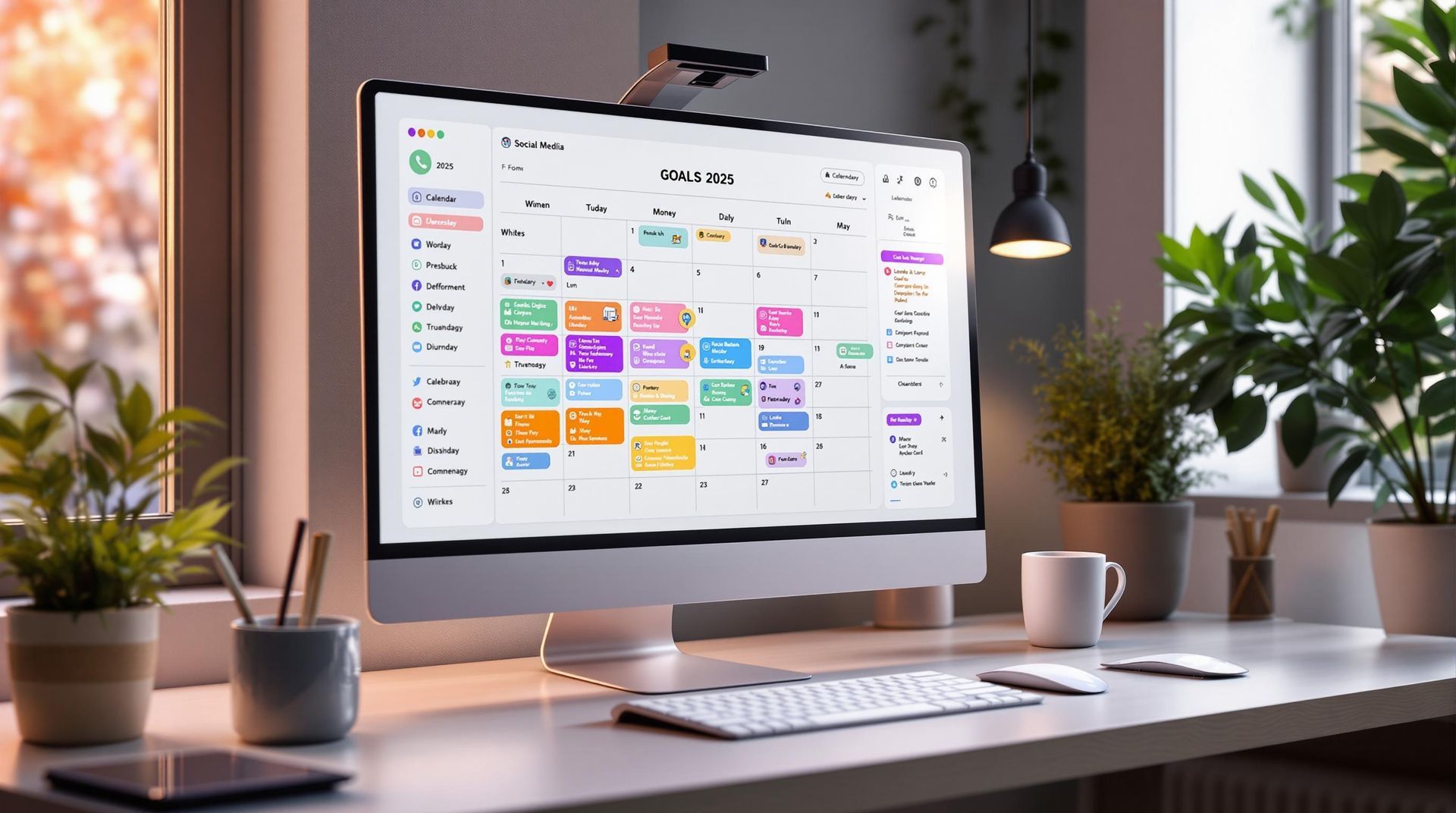AWHITNEY DIGITAL MARKETING
Social Media Analytics: Key Metrics for Business Growth
December 12, 2024
Unleash the Power of Social Media Metrics to Drive Growth and Outpace Competitors
Social media analytics is crucial for driving business growth. Here's what you need to know:
- Analytics help you understand your audience and improve content
- Key metrics include engagement, reach, conversions, and ROI
- Popular tools: platform-specific analytics, Sprout Social, Hootsuite Insights
- Data-driven decisions lead to better results (e.g. PureGym's 11% membership increase)
Top metrics to track:
- Engagement (likes, shares, comments)
- Reach and impressions
- Conversion rates
- Click-through rates (CTR)
- Return on investment (ROI)
To get started:
- Set clear, measurable goals
- Choose the right analytics tools
- Create regular reports
- Analyze data to refine your strategy
Related video from YouTube
Key Social Media Metrics
Let's look at the numbers that can make or break your social media strategy:
User Interaction Numbers
These show how people engage with your content:
- Likes
- Shares
- Comments
- Clicks
High engagement often means your content hits the mark.
Fun fact: Instagram usually sees more engagement than Facebook or Twitter. In 2020, Instagram's average engagement per post was way higher than its rivals.
Content Visibility Stats
These tell you how many eyeballs your posts are getting:
- Reach: Unique users who saw your content
- Impressions: Times your post showed up
Here's a tip: Reach and impressions aren't the same. You might have 1,000 impressions but only reach 500 people if some folks saw your post twice.
Sales and Return Metrics
These link your social media work to business results:
- Conversion rate
- Click-through rate (CTR)
- Cost per click (CPC)
- Return on investment (ROI)
Alex York from SproutSocial says:
"Engagement, for me, is a long term relationship."
It's not just about quick sales. It's about building lasting customer bonds through social media.
Customer Feedback Scores
These give you a peek into customer happiness:
- Net Promoter Score (NPS)
- Customer satisfaction ratings
- Sentiment analysis of comments and mentions
Here's a shocker: John Kopanakis, a professor at Hellenic Mediterranean University, found that while 80% of online businesses think they're nailing it on social media, only 8% of their customers agree. Yikes!
Brand Image Metrics
These help you get how people see your brand online:
- Brand mentions
- Share of voice
- Sentiment analysis of brand chatter
Jenny Gardynski from G2 shares her approach:
"When it comes to our organic social media presence, we look at metrics that demonstrate both our reach and engagement – in support of driving G2's brand awareness. Key metrics we measure include follower count, impressions, and post link clicks."
Keep an eye on these metrics, and you'll get a clear picture of your social media performance. Remember, it's not just about the numbers - it's about what they tell you about your audience and your brand's online presence.
Tools for Tracking Social Media
Let's dive into some top tools for keeping tabs on your social media game:
Built-in Platform Tools
Most social platforms come with their own analytics. Here's what you get:
Instagram Insights: For business and creator accounts. Shows you:
- Reach and interactions (last 90 days)
- Follower info (countries, cities, age, gender)
Meta Business Suite: Free tool for Facebook and Instagram. Gives you:
- Facebook Page analytics
- Ad spend data
- Organic content engagement
Jenny Gardynski from G2 says:
"When it comes to our organic social media presence, we look at metrics that demonstrate both our reach and engagement – in support of driving G2's brand awareness. Key metrics we measure include follower count, impressions, and post link clicks."
Creator Studio: Another free Meta tool. Helps you:
- Manage Facebook and Instagram
- Schedule content
- Track performance
Outside Analysis Tools
Third-party tools often pack more punch:
Sprout Social:
- Tracks multiple networks
- Creates custom reports
- Shows competitor activity
The University of North Dakota used it to boost their social media game.
- Starts at $29/month
- Automates reports
- Tracks audience engagement across platforms
- Starts at $89/month
- Gives real-time analysis
- Monitors brand mentions
- Tracks competitors
- Great for Twitter and Instagram
- Starts at $199/month
- Analyzes online trends
- Helps plan content
- Finds industry influencers
AWhitney Digital Marketing's Tools

For Tampa businesses, AWhitney Digital Marketing offers:
Comprehensive Analytics Package:
- Starts at $889/month
- Analyzes performance across platforms
- Tracks engagement, reach, and conversions
Custom Reporting:
- Easy-to-understand reports
- Focuses on your key metrics
Competitive Analysis:
- Uses tools like RivalIQ
- Gives insights into competitor strategies
Remember, it's not just about collecting data. It's about using it to make smart moves.
As Alex York from Sprout Social puts it:
"Engagement, for me, is a long term relationship."
Choose the tools that fit your needs and budget. Then use the data to grow your social media presence and your business.
Elevate Your Digital Presence
Partner with AWhitney Digital Marketing for expert SEO, targeted PPC campaigns, and comprehensive digital strategies to boost your business growth.
Using Data to Plan Better
Social media data isn't just numbers. It's a treasure trove of insights that can boost your marketing strategy. Here's how to turn those metrics into action plans.
Setting Clear Goals
First, know what you're aiming for. Set SMART goals:
- Specific
- Measurable
- Achievable
- Relevant
- Time-bound
HeyOrca, a social media management platform, nailed this with their goal:
"Grow our LinkedIn community this month by increasing engagement rate to 18%, generating 80 mentions, and adding 20 newsletter signups from social."
Your social media goals should link directly to your business objectives.
As Alexander Chafe, a marketer and content writer, says:
"To measure success, you first have to know what you want to achieve."
Tracking Progress
Once you've set goals, keep score. Use tools like Google Analytics, Hootsuite Insights, or Sprout Social to track key metrics.
Don't just look at your own numbers. Compare your progress against industry standards and your past performance. This gives you context and helps you spot trends.
Netflix uses social media insights to analyze viewer behavior and preferences. This helps them create personalized recommendations and promote new content to the right audience.
Making Content Work Better
Use your insights to refine your content strategy. The Sprout Social Index™ 2023 found that consumers want more authentic, non-promotional content. They also want posts that show transparency about business practices and values.
How to apply this?
Do a content audit. Look at what's working and what's not. Then, adjust your strategy.
Airbnb has mastered this. They use social media insights to identify popular travel destinations and customer preferences. This allows them to create more relevant experiences for their customers.
Spending Money Wisely
Use your data to guide your marketing budget. By understanding which efforts are most successful, you can allocate your resources more effectively.
PureGym is a great example. After tailoring their approach to Instagram and Facebook Reels ads, they saw an 11% increase in memberships. Even better, their cost per purchase decreased by 11% compared to their previous Reels ads.
This shows the power of data-driven decisions. By analyzing your metrics and adjusting your strategy, you can get better results without necessarily spending more.
Getting Started with Analytics
Let's dive into social media analytics:
Setting Up Your Tools
First, you need the right tools:
1. Choose your platform
Start with built-in analytics tools. Facebook Insights and Twitter Analytics are free and easy to use.
2. Set up access
Make sure you have admin access to your business accounts. For Facebook, you'll need a Facebook Page, not a personal profile.
3. Install tracking codes
If you're using a tool like Google Analytics, add a tracking code to your website. This tracks traffic from social media.
4. Connect your accounts
Most third-party tools need you to link your social media accounts. Just follow the prompts.
"Social media is sometimes perceived as a very new sphere for upper management, and getting sign-off without hard facts, data and ROI is a significant challenge." - Warren Talbot, Marketing Manager at Vans
Start with one or two platforms. This helps you build a solid case for expanding your analytics efforts.
Creating Regular Reports
Now, let's start reporting:
Pick metrics that match your goals. Want brand awareness? Track impressions and reach. Aiming for engagement? Look at likes, comments, and shares.
Monthly reports work well for most businesses. They give you enough data to spot trends without overwhelming you.
Create a template for your reports. Include sections for each platform and key metrics. Don't just list numbers - explain what they mean and how they relate to your goals.
Checking Results
Stay on top of your data:
- Glance at your dashboards daily. Look for any big changes in engagement.
- Once a week, dig deeper. Check out your best-performing content and figure out why it worked.
- At the end of each month, look for trends. Are certain types of content always doing well?
- Every three months, step back and look at the big picture. How are you doing with your yearly goals?
Updating Your Plan
Use your data to take action:
1. Find what works
Look for patterns in your top content. Do videos get more engagement? Are certain topics more popular?
2. Try new things
Based on what you find, experiment. If posts with images do better, try more visual content.
3. Change your strategy
Don't stick to a plan that's not working. If a platform isn't delivering, think about moving resources to more effective channels.
4. Set new goals
As you hit your targets, set new ones. Use your data to make sure these goals are realistic and achievable.
Summary
Social media analytics is key for successful digital marketing. Here's what you need to know:
Know Your Audience
Social media analytics helps you understand your audience's behavior and preferences. This knowledge is crucial for creating content that hits the mark.
Take PlayStation, for example. They grew their Twitter following by 376% from 2014 to 2019. How? By analyzing audience data and giving followers what they wanted: trailers and gameplay footage.
Check Your Engagement
Engagement metrics show how well your content connects with your audience. Here's a quick look at average engagement rates:
- Facebook: 0.018%
- Instagram: 0.90%
- Twitter: 0.05%
- TikTok: 2.65%
- LinkedIn: 0.54%
Use these numbers to see how you're doing and set realistic goals.
Measure Your ROI
You need to know if your social media efforts are paying off. The basic formula is:
Profit / Investment x 100 = social media ROI %
But remember, ROI isn't just about money. Better customer satisfaction or more brand awareness can be just as valuable.
Use the Right Tools
You'll need both built-in platform analytics and third-party tools for the full picture. Tools like Sprout Social, Sendible, and Keyhole can help you track multiple networks, create custom reports, and keep an eye on your competitors.
Make Data-Driven Decisions
Let analytics guide your strategy. Airbnb, for instance, uses social media insights to spot popular travel spots and what customers want. This helps them create experiences their customers love.
Keep Improving
Always analyze and adjust your strategy based on data. PureGym is a great example. They tweaked their approach to Instagram and Facebook Reels ads based on analytics.
The result? 11% more memberships and 11% lower cost per purchase.
As Jenny Gardynski from G2 puts it:
"When it comes to our organic social media presence, we look at metrics that demonstrate both our reach and engagement – in support of driving G2's brand awareness. Key metrics we measure include follower count, impressions, and post link clicks."
FAQs
What is KPIs in social media?
KPI means Key Performance Indicator. In social media, KPIs are the numbers that show if your strategy is working. They help you see if you're hitting your goals.
Some common social media KPIs are:
- How many people engage with your posts
- How many people see your content
- How fast you're gaining followers
- How often people click your links
- How many people take action after seeing your content
To make KPIs work for you, pick ones that match what you want to achieve. Keep an eye on these numbers and tweak your approach when needed.
What is the best analytics tool for social media?
There's no one-size-fits-all answer. The best tool depends on what you need, how much you can spend, and what you're trying to do. But here are some popular options:
1. Sprout Social
This tool gives you a full picture of your social media performance. You can create custom reports and see how you stack up against competitors.
2. Hootsuite Insights
With this one, you can see your stats in real-time. It also tells you what people think about your brand and what's trending.
3. Keyhole
If you use a lot of hashtags on Twitter or Instagram, this tool is great. It tracks them in real-time.
Want to know how you're doing compared to others in your industry? This tool is for you.
5. Awario
This one is all about listening to what people are saying about your brand online.
When picking a tool, think about:
- What you want to measure
- Which social media platforms you use most
- How much you can spend
- If it works with your other marketing tools
Most of these tools let you try them for free. So give them a test run before you buy.
For Tampa businesses, AWhitney Digital Marketing offers a package that starts at $889 per month.
They'll track how you're doing across platforms, see how people are interacting with your content, and give you reports that make sense for your business.

AWhitney Digital Marketing
We are the premier digital marketing solution in Tampa. Contact us today to get your free, no-obligation consultation!
All Rights Reserved | AWhitney Digital Marketing
Contact info
12212 Tattersall Park Lane, Tampa, Florida 33625
United States








